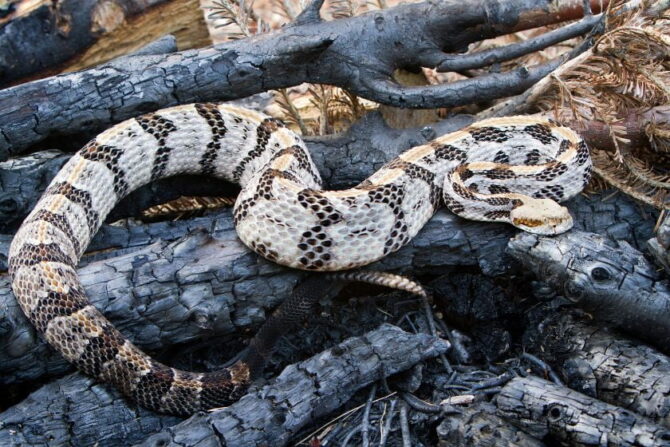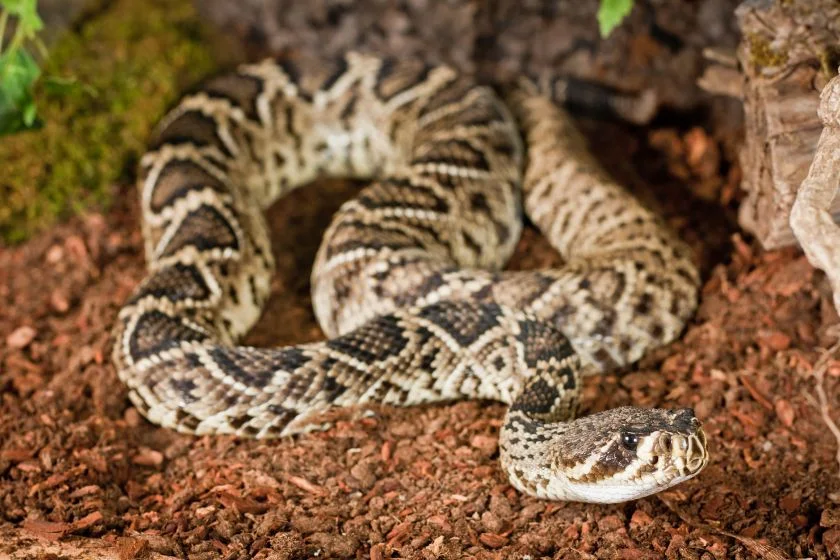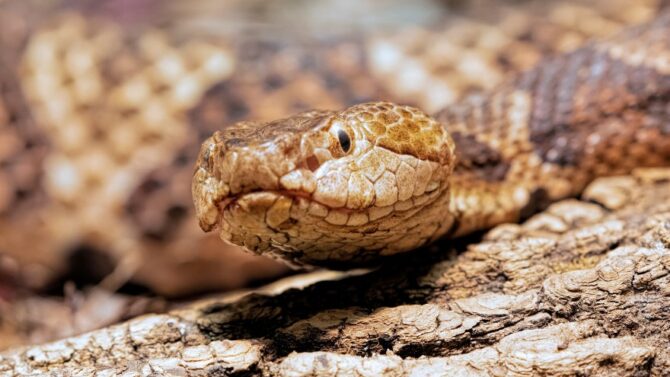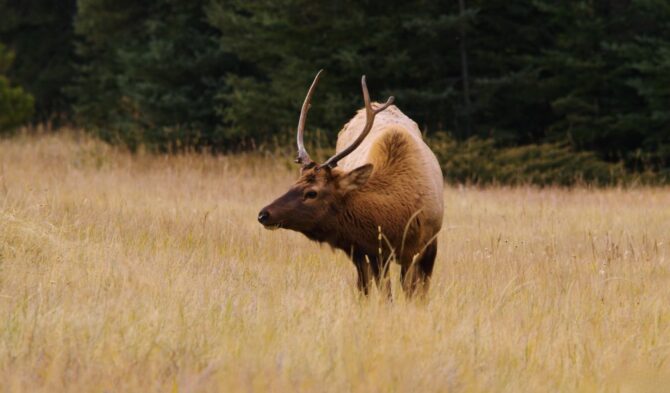Florida teems with many snake species, 44 to be exact. This would be concerning if all the species were venomous, but fortunately, that’s not the case.
Most of the snakes are non-venomous. There are only six poisonous snakes in the state, having their identifying markers.
The venomous snakes in Florida are the eastern copperhead, timber rattlesnake, coral snake, eastern diamond rattlesnake, cottonmouth, and Pygmy rattlesnake.
Let’s cover each of these deadly species in detail.
Venomous Snakes in Florida
1. Eastern Copperhead (Agkistrodon contortrix)

- Size: 20 to 37 inches
- Habitat: Deciduous forests, mixed woodlands, swamps, rock outcroppings
- Identifying Features: Broad head, pale tan color, patterns
- Behavior: Nocturnal, lying still
- Threats: Painful bites
The eastern copperhead is a pit viper, sometimes simply called the copperhead. It lives only in North America, specifically on the eastern side.
Florida is one of the many places this snake occurs in the United States.
Its main habitats are deciduous forests and mixed woodlands, but you can also find it in swamps and rock outcroppings.
Eastern copperheads are not as venomous as other pit vipers. Their lethal dose is 100mg, and it has been shown to not be as potent.
However, this doesn’t mean the Eastern copperhead is harmless.
Its bite is extremely painful, and the venom will still affect the victim negatively. It can cause nausea and swelling alongside the pain.
2. Timber Rattlesnake (Crotalus horridus)

- Size: 36 to 60 inches
- Habitat: Deciduous forests
- Identifying Features: Gray color, stripes on the back, pinkish hue
- Behavior: Docile, solitary
- Threats: Hemotoxin, neurotoxin
The timber rattlesnake is also a pit viper, much like the Eastern copperhead.
It is endemic to eastern North America, including Florida in the United States. Its main habitat is the deciduous forest.
The timber rattlesnake is common in its range, but in Florida the population is low.
Timber rattlesnakes are venomous and highly so. Their venoms contain both the hemotoxin and the neurotoxin, two highly dangerous substances.
A bite from this snake can render a person paralyzed or lose blood. Without effective treatment, the venom can be fatal.
The good news is the timber rattlesnake doesn’t bite unless provoked. It is shy and would rather avoid a human than get into a confrontation.
You’d also know it is around as it shakes the rattle at the tail to warn off intruders.
3. Eastern Diamondback Rattlesnake (Crotalus adamanteus)

- Size: 7.8 feet
- Habitat: Dry pine forests, sandhills, coastal maritime hammocks, salt marshes
- Identifying Features: Large head, bulky, blackish brown, olive or dusty gray color, patterns
- Behavior: Cold-blooded, solitary
- Threats: Long fangs, 400-450 mg venom, crotalase
The eastern diamondback rattlesnake is another pit viper living in Florida. It is endemic to the southeastern United States.
A big creature, it is considered the largest rattlesnake and the largest venomous snake in the Americas.
The eastern diamondback rattlesnake makes a home out of dry pine forests, sandhills, salt marshes, and coastal maritime hammocks.
Though it is not an aggressive snake, the eastern diamondback is considered the most dangerous venomous snake in North America.
This is because of its size, the potency of the venom, and its overall power. The eastern diamondback is not to be trifled with.
The enzyme in the venom–named crotalase–has its effects, causing symptoms like bleeding, swelling, and intense pain.
4. Cottonmouth (Agkistrodon piscivorus)

- Size: 26 to 35 inches
- Habitat: Creeks, streams, swamps, marshes
- Identifying Features: Broad head, black skin, patterns
- Behavior: Opening mouth, shaking tail, both diurnal and nocturnal
- Threats: Cytotoxin, venom yield 125mg, swelling, pain
The cottonmouth is named for its gaping behavior. When it feels threatened, the snake shakes its tail and leaves its mouth open, exposing a white within.
Other names include the Northern Cottonmouth, the swamp moccasin, the water moccasin, and the black mocassin.
Some people simply call it viper, though the term can be misleading.
Some experts also argue against using water moccasin as it can lead to confusion.
The cottonmouth is not as dangerous as rattlesnakes, but it surpasses the copperhead in potency.
While this snake is more likely to threaten than bite, it will do the latter if provoked.
The venom contains cytotoxin that destroys the tissue. Its bite isn’t always fatal, but it often requires medical attention. It certainly causes intense pain.
Cottonmouths can swim and are usually around creeks, streams, marshes, and swamps.
5. Eastern Coral Snake (Micrurus fulvius)

- Size: 31 inches
- Habitat: Glade land, high pine, scrub oak
- Identifying Features: Small, dorsal scales, black head
- Behavior: Solitary, not aggressive, terrestrial
- Threats: Neurotoxin, paralysis, respiration problems, double vision
The eastern coral snake is a beautiful species, but beauty can be deceptive when you factor in the venomous nature of this snake.
It is found only in the southeastern areas of the United States, staying mainly on the ground. It inhabits high pines, scrub oaks, and glade lines.
This snake is similar to the scarlet snake or the scarlet kingsnake, but these two are non-venomous.
On the other hand, the eastern coral snake is highly dangerous and constitutes a strong medical risk.
The neurotoxin contained in its venom is potent and can easily kill prey.
Humans can be saved if they get immediate treatment, but the symptoms are still disturbing. They include slurred speech, swelling, and double vision.
6. Pygmy Rattlesnake (Sistrurus miliarus)

- Size: 16 to 24 inches
- Habitat: Flatwoods, mixed forests, floodplains, lakes, marshes
- Identifying Features: dorsal patterns, slim tail with a rattle, diurnal
- Behavior: Nocturnal, solitary,
- Threats: Cytotoxin, painful bite
The pygmy rattlesnake is the smallest of its kind, but it should not be underestimated based on its size.
It is found only in the southeastern parts of the United States, which encompasses Florida.
The snake is often found in forests and other wooded areas, but it is not limited to these habitats. It also features marshes and lakes.
Like other rattlesnakes, the pygmy’s bite is painful and dangerous. The cytotoxin damages the victim’s tissues, further calling for medical attention.
Because of its size, some people may confuse it with a harmless snake and even pick it up.
Children are known to do this to their risk. Keep your kid away from an environment where these snakes may be.
Final Thoughts
Snakes can be fun to observe, but you need to stay away from the poisonous ones.
The risk faced with getting bit by a venomous snake is enormous, ranging from painful symptoms to actual death.
The cliche “prevention is better than cure” is helpful in this case. If you or someone you know get bit, find medical help immediately.






